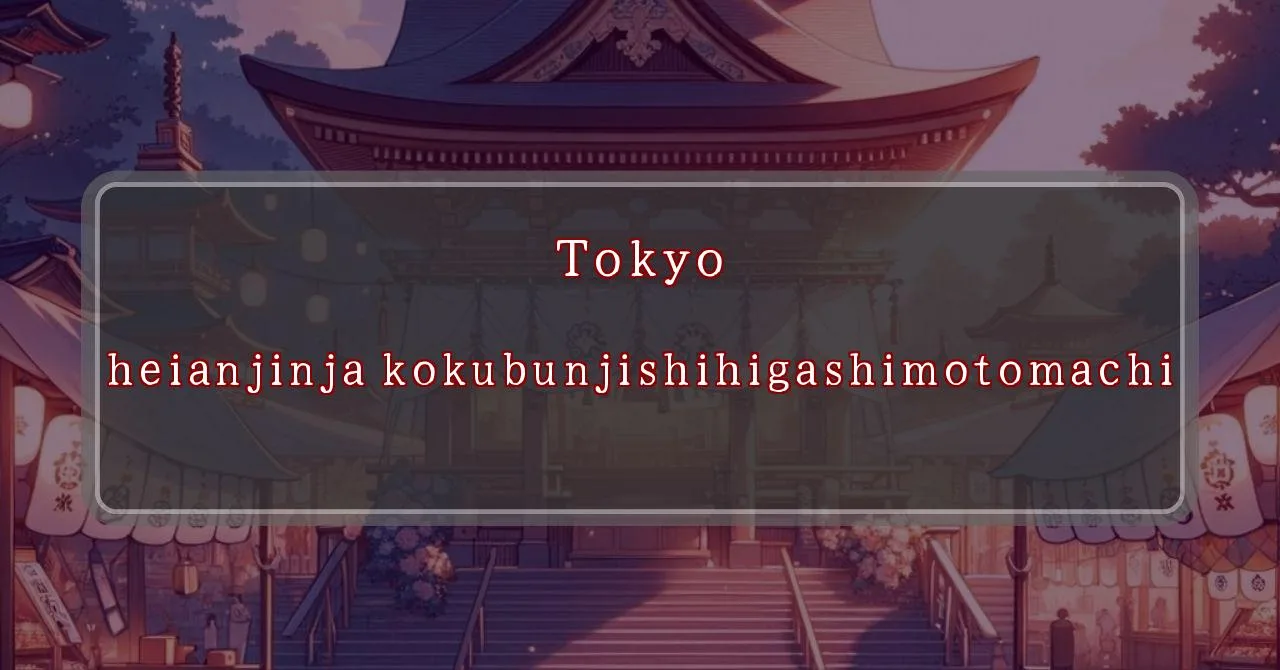Enchanting Shrine Festival in Kokubunji
Basic Information
Here is an overview of the 2024 Heian Shrine Kokubunji Higashimotomachi Festival.
- Address: 1-29-20 Higashimotomachi, Kokubunji-shi, Tokyo
- Phone Number: 042-323-2948
- Access: 12-minute walk from Kokubunji Station on the JR Chuo Line
- Festival Days: April 15th (Tue) and September 14th and 15th (Sat and Sun) in 2024
Main Events and Attractions of the Festival
The Heian Shrine Kokubunji Higashimotomachi Festival is a vibrant and lively event that offers a variety of attractions for visitors of all ages. Here are some of the main highlights of the festival:
Mikoshi Procession
One of the main highlights of the festival is the mikoshi procession. A mikoshi is a portable shrine that is carried through the streets by a group of people. The mikoshi is believed to be the temporary dwelling place of a deity, and the procession is a way of transporting the deity to different locations so that it can bless the people and the land. The mikoshi procession at the Heian Shrine Festival is a lively and colorful event, with people of all ages participating.
Lion Dance
Another popular attraction at the festival is the lion dance. The lion dance is a traditional Japanese dance that is performed by two people inside a lion costume. The lion is believed to be a symbol of good luck and fortune, and the dance is performed to bring good luck to the community. The lion dance at the Heian Shrine Festival is a lively and entertaining performance that is sure to delight visitors of all ages.
Food Stalls
No Japanese festival is complete without food stalls! At the Heian Shrine Festival, there will be a variety of food stalls selling a wide range of delicious Japanese food. From traditional festival favorites like yakisoba and takoyaki to more modern dishes like crepes and popcorn, there is something for everyone to enjoy. The food stalls are a great place to sample some of the best Japanese street food.
Blessings and Deities
The Heian Shrine Kokubunji Higashimotomachi Festival is dedicated to the deity Kukurihime no Kami. Kukurihime no Kami is a goddess who is said to have brought peace and harmony between the gods Izanagi and Izanami, who were arguing. She is also associated with marriage and childbirth. Visitors to the festival can pray to Kukurihime no Kami for blessings such as a happy marriage, a safe childbirth, and a harmonious family life.
Origin and History
The Heian Shrine Kokubunji Higashimotomachi Festival is a relatively new festival, having been first held in 1946. However, the shrine itself has a long history, dating back to the Edo period. The shrine was originally called Shirakawa Shrine, but it was renamed Heian Shrine in 1946. The festival was created as a way to celebrate the shrine’s new name and to bring the community together.
Tips and Notes for Visitors
If you are planning to attend the Heian Shrine Kokubunji Higashimotomachi Festival, here are a few tips and notes to keep in mind:
- The festival is held on April 15th and September 14th and 15th each year.
- The festival is a popular event, so it is important to arrive early to avoid crowds.
- There is a variety of food and drink available at the festival, so you can enjoy a picnic lunch or dinner.
- There are also a number of activities for children, such as games and rides.
- The festival is a great opportunity to learn about Japanese culture and traditions.
Parking Information
There is limited parking available at the Heian Shrine. If you are driving to the festival, it is recommended that you park at a nearby train station and take the train to Kokubunji Station. From Kokubunji Station, it is a 12-minute walk to the shrine.
Popular Stalls and Food Carts in Recent Years
| Type of Stall | Description |
|---|---|
| Takoyaki | A staple at Japanese festivals. Characterized by a crispy outside and a creamy inside. |
| Jaga Butter | A simple yet popular snack of hot potatoes lavishly topped with melted butter. |
| Baby Castella | Small castella cakes, sweet and fluffy treats enjoyed by children and adults alike. |
| Grilled Ayu with Salt | Fresh ayu fish grilled whole with salt, a savory taste of Japanese summer. |
| Shaapin | A unique gourmet item influenced by foreign cuisine, with a chewy skin wrapping the filling. |
| Okonomiyaki | A Japanese grilled dish where you often choose your own ingredients for a personalized flavor. |
| Cotton Candy | A fluffy, sweet snack that’s extremely popular with children. |
| Chocolate Banana | A banana coated in chocolate, a fun and visually appealing dessert. |
| Kushiyaki | Various types of ingredients skewered and grilled, an easy-to-enjoy snack. |
| Yakisoba | Fried noodles mixed with a special sauce, a fast food favorite in Japan. |



